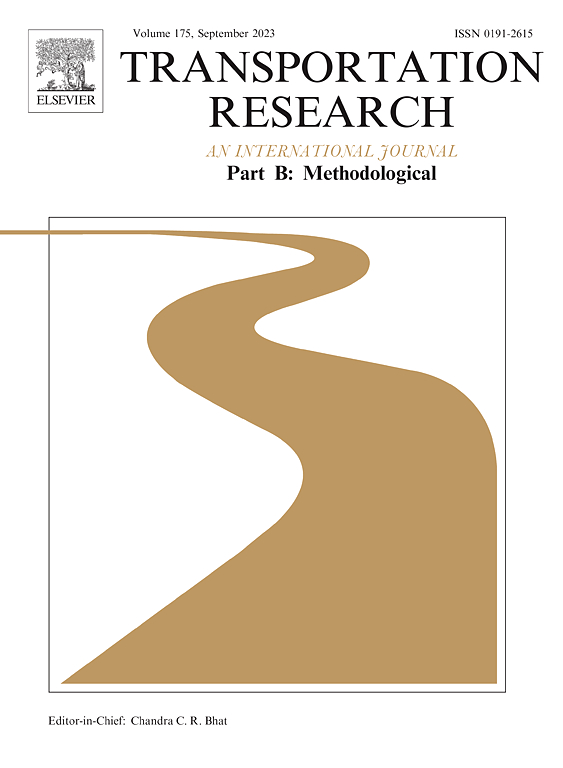电动汽车动态交通分配
IF 6.3
1区 工程技术
Q1 ECONOMICS
引用次数: 0
摘要
我们启动了电动汽车动态交通分配的研究,以解决诸如里程限制和电池在预定充电地点充电的可能性等具体挑战。作为我们的主要成果,我们利用Vickrey的确定性排队模型建立了网络中能量可行的动态均衡的存在性。要得到这个存在性结果,有三个关键的建模要素:1。我们引入了一个基于步行的动态交通流定义,该定义允许循环路由行为作为路由2中的充电事件的结果。我们在适当的函数空间中使用抽象凸可行性集来模拟所使用的步行的能量可行性。引入了容化动态平衡行走流的概念,对以往的无限制动态平衡路径流进行了推广。在此框架下,我们通过应用无限维变分不等式证明了能量可行动态平衡的存在,这反过来又需要仔细分析由于向行走中注入流动而导致的网络负载的连续性特性。我们通过一个计算研究来补充我们的理论结果,其中我们设计了一个计算能量可行动态平衡的定点算法。我们将该算法应用于来自流量分配社区的标准现实世界实例。研究表明,与传统燃油汽车相比,电池限制对行驶时间和能源消耗有重大影响。我们进一步表明,我们的算法在可接受的运行时间内计算中小型实例的(近似)平衡,但对于较大的实例则难以计算。本文章由计算机程序翻译,如有差异,请以英文原文为准。
Dynamic traffic assignment for electric vehicles
We initiate the study of dynamic traffic assignment for electrical vehicles addressing the specific challenges such as range limitations and the possibility of battery recharge at predefined charging locations. As our main result, we establish the existence of energy-feasible dynamic equilibria within networks using the deterministic queuing model of Vickrey for the flow dynamics on edges.
There are three key modeling-ingredients for obtaining this existence result:
1. We introduce a walk-based definition of dynamic traffic flows which allows for cyclic routing behavior as a result of recharging events en route.
2. We use abstract convex feasibility sets in an appropriate function space to model the energy-feasibility of used walks.
3. We introduce the concept of capacitated dynamic equilibrium walk-flows which generalize the former unrestricted dynamic equilibrium path-flows.
Viewed in this framework, we show the existence of an energy-feasible dynamic equilibrium by applying an infinite dimensional variational inequality, which in turn requires a careful analysis of continuity properties of the network loading as a result of injecting flow into walks.
We complement our theoretical results by a computational study in which we design a fixed-point algorithm computing energy-feasible dynamic equilibria. We apply the algorithm to standard real-world instances from the traffic assignment community. The study demonstrates that battery constraints have a significant impact on the resulting travel times and energy consumption profiles compared to conventional fuel-based vehicles. We further show that our algorithm computes (approximate) equilibria for small and medium sized instances in acceptable running times but struggles for larger instances.
求助全文
通过发布文献求助,成功后即可免费获取论文全文。
去求助
来源期刊
CiteScore
12.40
自引率
8.80%
发文量
143
审稿时长
14.1 weeks
期刊介绍:
Transportation Research: Part B publishes papers on all methodological aspects of the subject, particularly those that require mathematical analysis. The general theme of the journal is the development and solution of problems that are adequately motivated to deal with important aspects of the design and/or analysis of transportation systems. Areas covered include: traffic flow; design and analysis of transportation networks; control and scheduling; optimization; queuing theory; logistics; supply chains; development and application of statistical, econometric and mathematical models to address transportation problems; cost models; pricing and/or investment; traveler or shipper behavior; cost-benefit methodologies.

 求助内容:
求助内容: 应助结果提醒方式:
应助结果提醒方式:


